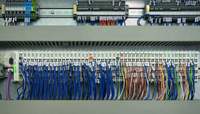Fritz's bread baking machines have the obvious advantages of high quality and fail-safety, and they are all manufactured to meet customer needs. These machines must be tested for 24 hours a day, at least 6 days. System components such as servo motors should also meet the same high requirements. Servo motors are used to accurately position and adjust the distance between two rollers (roll gap), so that bread dough can always be produced with appropriate strength. In order to achieve the precise positioning and adjustment of this roller gap, Fritz has tried to use a variety of motors, such as AC motors, stepper motors, etc. But in the end, the DC servo motor was the best choice. DC servo motor control "Using a DC drive motor to position the machine between the rolls is very well tested. It is not only strong in performance, low in cost and long-lasting", said Gerhard Danzig, manager of the electrical department at Fritz. If the baking method is changed, the roller gap of the machine needs to be repositioned and adjusted. However, it is not easy to achieve the desired accuracy between the rollers. Positioning with a DC motor is simple and powerful but the accuracy is not high enough. Previously, the working mode of DC motors was to rotate a fixed number of revolutions to the left or right at a speed below 1 m / s. As far as the positioning method is concerned, shaft positioning is the simplest one, but it is not easy to achieve high-precision roller positioning between 3 / 100mm. There is no strict requirement on the time of the positioning process, because the replacement of baked products often takes a few minutes. Within this range, the motor has sufficient time to complete the positioning work. The user chose WAGO's DC drive controller as a solution. "Now we set a theoretical value, and then the DC motor starts to automatically rotate to the correct position. The actual position reached by the motor is exactly the same as the theoretical value set at the beginning. This motor is rigorously designed to avoid overshoot The function of the motor is very reliable, "said the manager of the Fritz Electric Department. Intelligent positioning control The 750-636 series DC drive controller is a single-channel intelligent positioning controller with incremental position feedback function. It is suitable for 24V DC motors with a rated current of 5A. The controller does not depend on the fieldbus type and can be used as The bus module is integrated into WAGO-I / O-SYSTEM, and three 24V DC input channels are used to collect terminal switch and preset signal information. It also has an incremental encoder sensor interface that calculates the signal from the position transmitter and determines the actual value. The positioning function will optimize the pre-breaking positioning according to the direction according to the needs, and fully consider the adjustment compensation of the gear mesh clearance. The two rotation directions of the DC motor are controlled by an H-bridge circuit with short-circuit protection and temperature monitoring. Whether it is switching direction, soft start / stop, or reducing current, it can be achieved by pulse width modulation (PWM). Pulse width modulation control can control the number of revolutions or torque within a running cycle, and the current and temperature monitoring functions can avoid overload. Debugging and diagnosis can be achieved through the interface of WAGO-I / O-CHECK software tool. The controller can make the servo motor overcome its own limitations through a special process principle to achieve amazing accuracy. As a result, the servo motor runs to the preset target range and stops running when the power is turned off on time. It can identify the target by measuring the distance traveled by the motor. The tolerance range is set in advance and is continuously monitored during the process of reaching the target. If there is a deviation, it will be automatically adjusted, which makes the motor control process more plastic. . This kind of control is equivalent to: when friction or contamination occurs in the calibration adjustment range, timely implement lubrication maintenance measures for the calibration shaft. Taking the way to cut off the power of the motor in advance or later makes it easier to achieve the goal in the next adjustment and calibration process. Although the applied process principle runs for only a few seconds, its simple structure can save money. The gear with automatic braking function acts as a brake. The cancellation of the holding torque serves the purpose of saving energy. At this time, the power source needs only a small amount of power, and the power is directly transmitted to the motor without conversion. A total of 12 servo motors were used in the large industrial system (Impressa project) in Fritz. "The DC drive controller has a compact form factor and a modular structure with a width of only 12mm, which replaces many previous important hardware such as contactors, counter cards and digital input channels." Gerhard Danzig also talked about the spatial structure of the controller Advantages. "Now we only need 20% of the original installation space." Dog Training System Accessories Dog Training System,Shock Collar System,Sportdog Contain And Train,The Perfect Dog Training System Elite-tek Electronics Ltd , https://www.aetertek.ca
How to implement ideal control of servo motor
Fritsch GmbH is a world-leading manufacturer of baking machines and systems. They chose to apply DC 24V servo motors to implement system setup and adjustment functions. The company chose WAGO's DC drive controller, which follows the unique process standards in the production process to make it have extremely high accuracy, so that Fritz has intelligent and powerful system control.